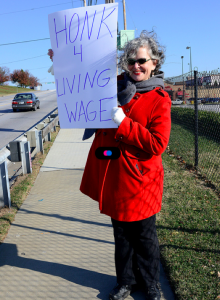 The following is a guest post by Anne Ladky, Executive Director of Women Employed
The following is a guest post by Anne Ladky, Executive Director of Women Employed
Food stamps, slashed. Hundreds of protests over low wages, including one in St. Paul that ended with the arrest of 26 protesters—and plans in 100 cities for fast food strikes this very Thursday. A Wal-Mart food drive gathering Thanksgiving donations for its own underpaid employees. Even conservatives calling for a raise in the minimum wage.
Something is in the air. Whether it’s the generosity of holiday spirits or just people finally reaching a breaking point with the status quo, Americans are restless; we want change. And now, when people are paying attention to the plight of the struggling worker, is a rare opportunity to actually make things happen.
When I first joined Women Employed, there was a different kind of restlessness in the air. This was in the 70s, and women were getting fed up with those who outright opposed us getting into managerial and professional jobs. They said we weren’t capable, that we were only working for “pin money” anyway, and that we belonged at home.
WE was founded by women who wanted to change that world—and we succeeded. This year marked our 40th anniversary, and we have plenty to celebrate. In the past four decades, women have reshaped the American workplace. Our progress can be seen in laws against pregnancy discrimination and sexual harassment, family leave policies, and the breadth of opportunities available to women today, especially those with college degrees.
But celebrating women’s progress all too often obscures the reality that many women are still struggling just to get by. Although the advances of the past 40 years have given women many more opportunities, not all of us have been able to take advantage of them; millions have been left behind.
One way to think of it is to imagine that women today live on two different planets. On the first planet, women work in professional, managerial, or union jobs and earn salaries high enough to support a family. We have paid sick time, vacation time, health insurance. And we think of that as standard. Things aren’t perfect—women still struggle with glass ceilings, bad attitudes, and pay issues. But there’s some flexibility to deal with the demands of work and family, and women with education and advantages are doing better than they ever have before.
On the other planet are the millions of women who work hard in jobs we all depend on—jobs in restaurants, retail, call centers, day care centers, and the homes of our elderly parents. Their wages are far too low. 17 million women today—almost a third of the female workforce—are earning less than $12 an hour. They have no paid sick time or vacation time and limited, if any, access to benefits. They get little or no respect for the work they do, and their hard work doesn’t lift them out of poverty. Their struggles are often invisible or ignored, even though their poverty hurts our society’s children, our communities, and our economy.
This can’t continue. We have to say no to having one world of work for women with education and advantages and a vastly inferior world of work for others. We need to shine the spotlight on those low-income working women who work their days serving meals to others but can barely feed their own children, the women who take care of our bedridden family members but don’t get paid sick days themselves.
We’ve cracked the glass ceiling—in some cases, we’ve even shattered it. But we can’t just look up; we have to look down. We need to raise the floor. Fortunately, there are some specific ways to do this, and the recent movement to increase the minimum wage is one of them. If we just raised the federal minimum wage to $10.10 an hour over a period of years—a proposal that President Obama has just backed—we would generate an estimated $32 billion in new economic activity and an estimated 140,000 new full-time jobs. We need to expand the right to earned sick time—and make sure that current movements to block states from ever being able to mandate paid sick days are stopped in their tracks. We need to ensure that more workplaces have policies that guarantee equal opportunity, fairness, and respect for family responsibilities—not just for higher-ups, but at every level of employment. We need to create stronger career pathways by enabling low-income women to get the education and training they need to advance.
This won’t be easy. The fact that we’re still fighting some of the same fights as when WE was founded (read: the wage gap barely changed in the last decade) shows just how long-term this struggle is. But the last 40 years offers plenty of inspiration to face future obstacles. In the 70s, we were dealing with problems no one had even given names to—sexual harassment, gender wage gap, wage theft. Today, we don’t only have words for these things, we’ve put laws in place to protect women against them. Time and again, we’ve made history. But there’s plenty left to be made.


Comments 1
donna gutman — December 9, 2013
What a fabulous article - working women orbiting in 2 completely disparate paths in the same universe. The most important task for professional women - look down and raise awareness of this chasm. All women live under the same sky and share the same needs. Support great organizations like Women Employed in changing the landscape for these underserved women who are indeed the working poor.